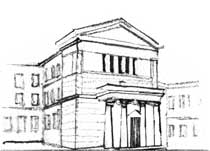Soft Matter and Complex Systems Seminar
2006/2007 | 2007/2008 | 2008/2009 | 2009/2010 | 2010/2011 | 2011/2012 | 2012/2013 | 2013/2014 | 2014/2015 | 2015/2016 | 2016/2017 | 2017/2018 | 2018/2019 | 2019/2020 | 2020/2021 | 2021/2022 | 2022/2023 | 2023/2024 | 2024/2025
2020-11-06 (Friday)
Karol Capała (Marian Smoluchowski Institute of Physics, Jagiellonian University)
Kramers-like problem for Lévy flights
A noise induced escape of a particle is one of the archetypal problemsin stochastic dynamics. Among others, it was studied by H. A. Kramersin the case of the Gaussian white noise in overdamped (largeviscosity) and underdamped (small viscosity) regimes. In theoverdamped regime, the obtained formula for the reaction rate can beinterpreted as the Arrhenius equation. Therefore, the stochasticmotion in the double-well potential can be used as an effective modelof chemical reactions.
Since then, the noise induced escape of a particle was intensivelystudied in the overdamped and underdamped regimes as well as inquantum setups. I will present extension of problem of the transitionrates in a double-well potential to the case of Lévy noises in bothover- and underdamped regime.
The seminar will be conducted on Zoom
https://zoom.us/j/92987083349?pwd=YTZLSFVWUnJzdE4xS1drR3dqMVFDdz09
Meeting ID: 929 8708 3349
Passcode: a8QhyS
Since then, the noise induced escape of a particle was intensivelystudied in the overdamped and underdamped regimes as well as inquantum setups. I will present extension of problem of the transitionrates in a double-well potential to the case of Lévy noises in bothover- and underdamped regime.
The seminar will be conducted on Zoom
https://zoom.us/j/92987083349?pwd=YTZLSFVWUnJzdE4xS1drR3dqMVFDdz09
Meeting ID: 929 8708 3349
Passcode: a8QhyS
2020-10-30 (Friday)
Radost Waszkiewicz (IFT UW)
Dynamics and shape of DNA minicircles
In most organisms, DNA is in an underwound or overwound state, however, typical experiments involve short linear segments of DNA which have relaxed twist.
Closing the DNA in circular loops, allows the twist to be maintained during an experiment to study the effect of under/overwinding on its properties, but changing DNA segment topology changes all the relevant forces: elastic, hydrodynamic and Brownian. Such loops are already being synthesised in laboratories but suitable theoretical description is needed to interpret experimental results.
To this aim, we consider simplified models of DNA loops. Using resistive force theory we are able to understand the influence of drag on the shape of minicircles. Furthermore, using Timoshenko beam theory, we can explore the influence of the imposed twist on shape and Brownian fluctuations. Our results indicate that, for small enough minicircles, it is the elastic forces that lead to multiplicity of observed shape configurations.
The seminar will be conducted on Zoom
https://zoom.us/j/92987083349?pwd=YTZLSFVWUnJzdE4xS1drR3dqMVFDdz09
Meeting ID: 929 8708 3349
Passcode: a8QhyS
Closing the DNA in circular loops, allows the twist to be maintained during an experiment to study the effect of under/overwinding on its properties, but changing DNA segment topology changes all the relevant forces: elastic, hydrodynamic and Brownian. Such loops are already being synthesised in laboratories but suitable theoretical description is needed to interpret experimental results.
To this aim, we consider simplified models of DNA loops. Using resistive force theory we are able to understand the influence of drag on the shape of minicircles. Furthermore, using Timoshenko beam theory, we can explore the influence of the imposed twist on shape and Brownian fluctuations. Our results indicate that, for small enough minicircles, it is the elastic forces that lead to multiplicity of observed shape configurations.
The seminar will be conducted on Zoom
https://zoom.us/j/92987083349?pwd=YTZLSFVWUnJzdE4xS1drR3dqMVFDdz09
Meeting ID: 929 8708 3349
Passcode: a8QhyS
2020-10-23 (Friday)
Max Cooper (IFT UW)
Modeling cave cross-section evolution and the effect of mechanical versus chemical erosion
Deposits within caves are often used to interpret past landscape evolution and climate conditions. However, cave passage shapes also preserve information about past conditions. Despite the usefulness of passage shape, numerical models of cave formation neglect cross-section evolution. To address this gap a model for evolving cave passage cross‐sections is developed using a shear stress estimation algorithm and a shear stress erosion rule. The model qualitatively duplicates observed cave passage shapes so long as erosion rates vary with shear stress, as in the case of transport limited dissolution or mechanical erosion. Existing scaling relationships from bedrock channel literature of width to discharge are duplicated, and further explored for varying erosion mechanism. Additionally, this scaling relationship is explored for natural distribution of discharge instead of treatment as a single mean value.
When sediment transport and alluviation is added to the model we successfully simulate paragenetic channels, a type of passage that forms when sediment armors the floor of the cave, forcing upwards erosion under pressurized conditions. An approximate scaling relationship indicates that equilibrium paragenetic channel width scales strongly with discharge, and weakly with the inverse of sediment supply. Simulations confirm the relationship and show that erosion mechanism, sediment size, and roughness are secondary controls.
The model is also adapted to simulate cross-sections of cave meander bends. Simulations of meander cross-sections reveal that the relationship between the contrast in shear stress on either wall and the incision angle of the meander record erosion mechanisms, allowing mechanisms to be determined in the field. Field measurements of such data indicate mechanical erosion plays a larger in the formation of caves than assumed in the karst literature. Totality of modeled cave cross-sections and measured data strongly indicate previous hypotheses of cave formation in turbulent flow need adjustment, and further data must be collected to determine erosion mechanisms in caves.
The seminar will be conducted on Zoom
https://zoom.us/j/92987083349?pwd=YTZLSFVWUnJzdE4xS1drR3dqMVFDdz09
Meeting ID: 929 8708 3349
Passcode: a8QhyS
When sediment transport and alluviation is added to the model we successfully simulate paragenetic channels, a type of passage that forms when sediment armors the floor of the cave, forcing upwards erosion under pressurized conditions. An approximate scaling relationship indicates that equilibrium paragenetic channel width scales strongly with discharge, and weakly with the inverse of sediment supply. Simulations confirm the relationship and show that erosion mechanism, sediment size, and roughness are secondary controls.
The model is also adapted to simulate cross-sections of cave meander bends. Simulations of meander cross-sections reveal that the relationship between the contrast in shear stress on either wall and the incision angle of the meander record erosion mechanisms, allowing mechanisms to be determined in the field. Field measurements of such data indicate mechanical erosion plays a larger in the formation of caves than assumed in the karst literature. Totality of modeled cave cross-sections and measured data strongly indicate previous hypotheses of cave formation in turbulent flow need adjustment, and further data must be collected to determine erosion mechanisms in caves.
The seminar will be conducted on Zoom
https://zoom.us/j/92987083349?pwd=YTZLSFVWUnJzdE4xS1drR3dqMVFDdz09
Meeting ID: 929 8708 3349
Passcode: a8QhyS
2020-10-16 (Friday)
Tomasz Skóra (IChF PAN)
Macromolecular Crowding: How the Shape of Macromolecules Affects Diffusion?
Significant fraction of cell’s volume is occupied by various proteins, polysaccharides, RNAs etc. Such crowding substantially reduces the mobility of macromolecules, and affects both thermodynamics and kinetics of intracellular processes. While prior research has mainly focused on the dependence of translational mobility on occupied volume fraction, studies of the effect of crowder shape are still scarce. In this work, we fill this gap by investigating self-diffusion in mixtures of spherical and elongated macromolecules with Fluorescence Correlation Spectroscopy (FCS) and Brownian Dynamics (BD) simulations. Our results emphasize that diffusion in crowded systems is determined not merely by the occupied volume fraction, but that the shape of crowders matters, which is relevant to diverse intracellular environments.
The seminar will be conducted via Zoom
https://zoom.us/j/92987083349?pwd=YTZLSFVWUnJzdE4xS1drR3dqMVFDdz09
Meeting ID: 929 8708 3349
Passcode: a8QhyS
The seminar will be conducted via Zoom
https://zoom.us/j/92987083349?pwd=YTZLSFVWUnJzdE4xS1drR3dqMVFDdz09
Meeting ID: 929 8708 3349
Passcode: a8QhyS







